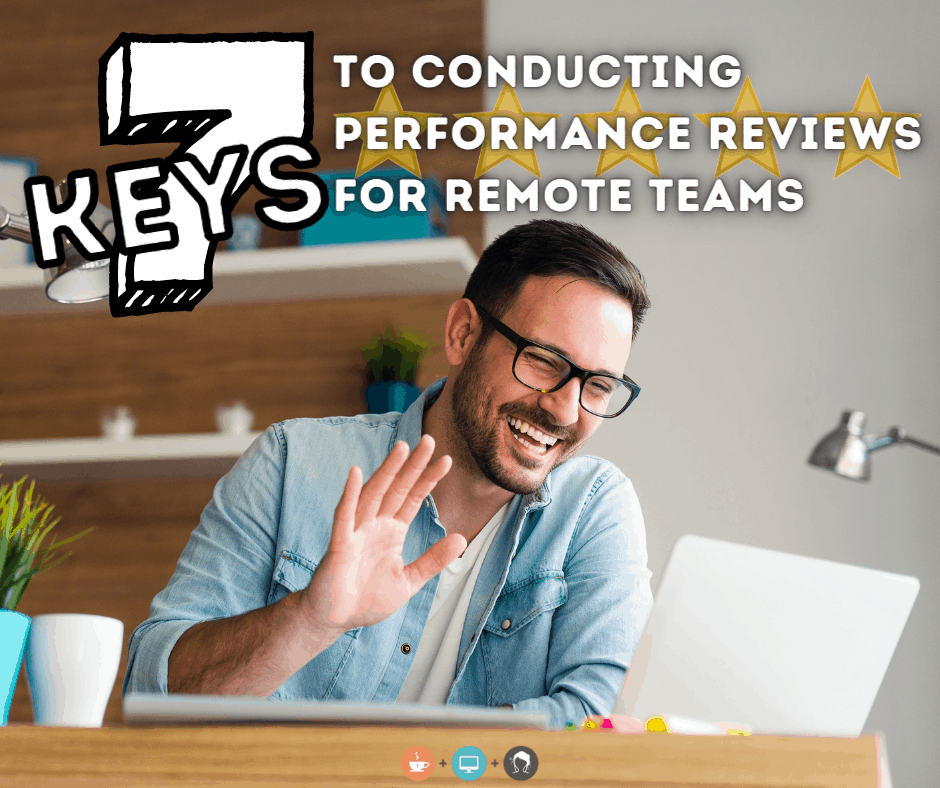
Seven Keys to Conducting Productive, Low-Stress Performance Reviews for Remote Teams
If the idea of delivering a performance review strikes fear in your heart, you are not alone. Many people rank receiving or giving a performance review right below getting a root canal. That’s because performance reviews are awkward. When you have a virtual team, performance reviews can feel that much more uncomfortable because you miss out on the benefit of seeing body language.
Although awkward, performance reviews are also essential. They can become comfortable affairs that lead to rich conversations and serve as a catalyst for growth for you and your team.
Having the right mindset for performance reviews is an excellent first step to making them more effective for you and your team. Specific tactics can help ease the planning and delivery process. Read on to find recommendations for both.
Keep the Objective in Mind
As you start thinking about performance reviews, remember why they are essential. Performance reviews lead to better performance and greater connection. They are not designed to serve as a “gotcha moment” or a time for recriminations. It’s not a report card like the ones issued in school. It’s a chance for two professionals to honestly discuss how things are going and to look to the future to consider possibilities.
All feedback sharing, and particularly performance reviews, are a tool to deepen relationships between you and your team members. As team members, you share the same goal. But, you both have different perspectives on success. As a business owner, you want to see your business succeed and likely derive great personal satisfaction from that success. Your employees crave personal success through a job well done. In the end, you know your people and understand that they care about the success of your business. Discussing performance is simply a shared acknowledgment of your relationship and its importance for your mutual success. It reflects a commitment to each other’s development.
Make Feedback an Ongoing Process
One way to make performance reviews easier is to share feedback throughout the year. Like any skill, practice makes progress. If you only share feedback at specific intervals, flexing the feedback muscle will feel unnatural. You can normalize the sharing of feedback to set a tone of open, two-way feedback with your team.
Try adding the phrase: “in the spirit of continual improvement” to your vocabulary when communicating with your team. Then, add observations of your performance as well as the groups. For example, try closing meetings with a few comments about the week and encourage employees to do the same. Encourage people to share thoughts about what’s going well and what’s not. Ask people what they are learning. Share your observations about how work is flowing and what you are learning. Be honest about the things you wish you’d done differently and point out that that it’s all in the spirit of continual improvement.
People feel heartened when their leaders are honest about what’s working and what’s not. Constant sharing promotes growth and normalizes the feedback process, especially when feedback is flowing in all directions.
Establish Set Intervals for Performance Reviews
As important as it is to offer ongoing feedback, establishing specific intervals to conduct performance reviews is also essential.
Many people find that an annual cycle offers the best timing for employee reviews. Annual reviews provide sufficient time intervals between reviews, allowing people to apply feedback from the prior year. This schedule generally works best for long-term employees who work on complex, long-lead projects.
Quarterly review cycles might be suitable for your team if your team members are less experienced, have a shorter tenure, and work on shorter-term projects. In this case, more frequent formal feedback can aid in development.
The key is that review intervals aren’t a one-size-fits-all affair. You might even use different cycles for different team members or at different points in your business. You’ll find success comes more effortless if you have a process in mind and share it with your team members, so you all know what to expect.
Set Yourself (and Your Team) Up for Success
You can take a lot of the stress out of performance reviews for you and your team by establishing a few rules of the road designed the ease the process for all parties.
- Follow a “no surprise” policy. One way to reduce trepidation is to avoid holding a year’s (or quarter’s) worth of developmental feedback until the official performance review. Instead, share developmental input along the way, so employees have a chance to act on it. Any feedback shared during a formal performance review should be a repeat of themes you’ve already discussed. Establish a policy that the performance review is not a time to share previously unheard grievances.
- Encourage two-way communication during the review. Approach the meeting as a discussion, where you and your employee both openly discuss feedback, not a lecture about all the things that went right or wrong.
- Take stock of the entire period. It’s easy to be swayed by recency bias and focus on the projects completed most recently. But, with a performance review, it’s vital to have an objective look back at the entire period encompassed for the review. To ensure you have a complete perspective, look back at notes, consider previous projects, and add results from work done across the review period.
- Gather more than one perspective for the person you are reviewing. If your team is large enough, ask team members to review each other and share their perspectives. If applicable, ask for customer and vendor feedback on each person’s performance. This practice can give you a fuller view of someone’s performance.
- Ask your team members to complete a self-evaluation as part of the review process. Encourage them to include perspectives on strengths and weaknesses over the last year and set goals for the coming year.
- Remove money discussions from the performance review. Let your team know that the review will take place in two parts. The first portion will focus on performance over the last period, looking forward to the coming year. The second part of the review process will include a discussion about pay, bonuses, and raises, if applicable. Setting this expectation makes for a more productive performance review and makes it easier for employees to hear your feedback rather than eagerly awaiting pay news.
Create a Comfortable Environment
Another way to reduce the stress associated with performance reviews is to create a comfortable situation for you and your employee. Here are some ways to do that:
- Schedule the review well in advance. About a month before the review, send an invitation to the employee so she can plan accordingly. Setting time aside makes it easier to focus on the review and shows that you see the review process as part of a meaningful conversation rather than just another task.
- Set aside enough time to talk. A good rule of thumb is to add 30 minutes to what you think you’ll need. That way, you won’t feel rushed, and you’ll be able to have a fuller conversation. If you are only sharing positive feedback, resist the temptation to cut this short and only schedule a brief review. Sometimes the richest conversations come about when time is available to talk. You can always end the call early.
- Share a written summary of the feedback in advance. Giving the employee a chance to review your feedback before the formal review leads to a more productive conversation, an opportunity to ask questions, and a fuller discussion of performance. It also means that you won’t have that awkward feeling of reading a review to your employee during the time set aside for the review.
- Use a comfortable format. If you regularly use Zoom or other video conferencing to connect, do the same for the performance review. This isn’t the time to try out new video conferencing software. An old-fashioned phone call is a great option if that makes it easier to talk more openly. Meet in person if schedules and distance allow.
- Be open to hearing the employee’s perspective on your thoughts. Her thoughts can provide you with greater insight into her performance and give you hints for coaching opportunities.
Arrange Your Own Performance Review
When you run the business, feedback on your performance can be tough to gather, and a formal performance review may not seem feasible. But, both are essential for your growth. Encourage contractors and employees to review you and offer feedback on areas where you excel and those where you can improve. This can open your eyes to some blind spots you might have in your performance and help you grow as a leader.
As you make the request, share this document with them and remind them of the no surprise policy. You will benefit when your team is open and honest with you.
How to Handle Negative Reactions
Despite your best intentions and after following all the guidelines outlined here, you may still encounter negative reactions from employees during a performance review. While it can be unsettling, try not to take it personally or to respond in kind. When employees are upset by performance evaluations, it shows they care and take their work seriously.
In some cases, it may be best to pause the review and let the employee take some time to regroup before finishing the discussion. Depending on the feedback, the two of you can decide the best way to move forward with the review and your relationship.
Finally, don’t shy away from performance reviews to avoid adverse reactions. Reviews are critical tools that can help your business grow, help you develop as a leader, and help your employees as they work toward personal success.
